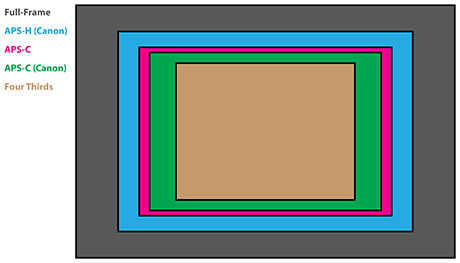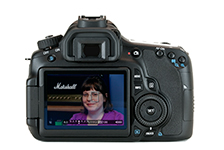Understanding
Digital SLR Specifications
Robert Correll
Author
Photographer
Musician
Here is an explanation of the major dSLR/dSLT specifications. Look in the camera's manual or on the product pages for specific camera specs.
Model: The type of digital SLR. You'll notice that each manufacturer has a certain approach to naming their cameras.
Nikon uses the letter "D" and then includes a number, such as with the D300. Canon, on the other hand, uses the term EOS to identify their digital SLR line and then the specific model number. They use ther term Rebel to identify their consumer dSLRs.
Year: When the camera was announced, and, give or take, when the camera first goes on sale.
There is a lot of turnover today. You won't find anything new for sale older than a few years. Unlike traditional film-based SLRs, digital SLR technology is changing and improving at a much faster rate. The moral of this story is not to fall in love with a camera body so much that you won't give it up. It as a temporary solution that will only last a handful of years before it becomes obsolete. That doesn't mean you can't take great photos with it for as long as you have the camera, but your lenses are your best long-term investment.
A corellary to this rule of thumb is to not waste money on a camera body that has features or performance you don't need. It will be out of date in a few years anyway.
Price: The price the manufacturer is asking for the camera, which may be different than what you may see advertised on Amazon.com and other retailers. The prices I have are for the standard camera kit, if possible. More advanced cameras may only be available as a body.
Type: This indicates the general category they fall into:
Professional: Over $2,000. On average, "entry-level professional" cameras begin between $2,000 and $2,500. On the high end you find Canon and Nikon cameras for $6,999 and $7,999, respectively.
Semi-Professional: Between $1,500 and $2,000. $1,700 or so is a sweet spot for this level.
High-End Amateur: Between $1,000 and $1,500. Professionals also use these cameras, although they are not typically considered pro-level. The reason is that these cameras generally don't have the feature set professionals need - whether in terms of hardware (sync connectivity) or the ability to configure and control the camera.
Mid-Range: Between $750-ish and $1,000. These are very good cameras, and $750 is not cheap, all things considered.
Entry-Level: Under about $750. The least expensive dSLRs are between $400 and $600. More advanced entry-level dSLRs range from around $600 to $750. At $750, you have to decide whether or not to get the "best" entry-level model or move up to a more basic mid-range camera.
Sensor Size(full/cropped): This identifies the camera's sensor size in terms of a 35mm frame of film (these are called "full-frame" cameras) or smaller (called "cropped-frame" dSLRs). Here is a summary of today's dSLR sensor sizes:

35mm: Also known as full-frame cameras. I identify them as "35mm". This means their sensor is the same size as a 35mm frame of film (which measures 36mm by 24mm). This is the "gold standard" of SLR film/sensor sizes. Nikon calls their full-frame cameras FX.
APS-H: This category is unique to Canon. It's in between full-frame and the smaller APS-C.
APS-C: This is the "standard" sensor size for most digital SLRs. It's actually much smaller than a 35mm frame of film, but still far larger than a compact digital camera sensor. Canon's APS-C sizes are a bit smaller than others. Nikon calls their APS-C cameras DX.
Four Thirds: At the moment, this size is unique to Olympus (within my lists). Four Thirds sensors have a 4:3 aspect ratio (of length to height) instead of the more traditional 3:2. Although the aspect ratio is not a factor in sensor size, Four Thirds sensors are all much smaller than full-frame dSLRs, and even smaller than APS-C sensors. The reason they are smaller is to be able to make the cameras cheaper and lighter, so they can compare in size (not considering the lens) of smaller compact digital cameras.
Of note, sensors fit into a certain category but may be off by a millimeter or two one way or another. You can sometimes find sensor size differences in cameras with the same sensor class from the same manufacturer.
Crop Factor: This is the number you mulitply the sensor size by to increase it to reach the same size as a 35mm frame of film. Larger numbers mean a smaller sensor.
Full-frame dSLRs have a crop factor of 1.0, which shows their sensors are the same size as a 35mm frame of film.
Most APS-C sensors have crop factors of 1.5 or 1.6.
Four Thirds sensors have a crop factor of 2.0 (remember, they are not the same aspect ratio, so even when you increase the size by a factor of two, the photo won't be the same as a 35mm frame of film).
The point here is to realize that the crop factor affects the effective focal length of the lens you're looking through. A 50mm lens on a full-frame dSLR has a field of view of around 46 degrees. The same lens has a narrower field of view (31.5 degress) on an APS-C camera. As a result, lenses feel more "zoomed in" when you're using them on a camera with a larger crop factor.
Megapixels (effective): This is different than the total number of pixels the camera sensor has. It's the area that actually produces the photo.
ISO: The normal ISO range of the camera. Sometimes a dSLR will allow you to "expand" this range either up or down. I don't list expanded ranges.
Larger maximum numbers indicate the camera can "turn up" the data from the sensor higher, which allows you to shoot in lower light conditions better without a flash. Photos shot at high ISOs, however, are noisier than those shot at lower levels. Exactly how much and whether or not they are usable depends on the quality of the camera.

Video: Whether a digital SLR shoots video and the type.
Weight (g, body only): How much the camera weights. I've been consistent about what number I've chosen from the camera manuals, but some manufacturers include the battery and memory cards while others do not. None should include a lens.








